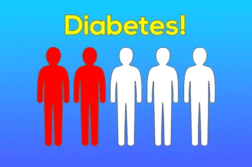Cleveland, Ohio. (Ivanhoe Newswire)— November is Diabetes Awareness Month. Diabetes is the leading cause of blindness, and it also contributes to kidney failure, poor circulation, and potentially, limb amputation. Now a national panel of experts in disease prevention has looked at recent clinical findings and is changing the diabetes screening guidelines.
One-hundred-sixty million Americans are overweight or obese, putting them at higher risk for developing type two diabetes. The U.S. Preventive Service Task Force has now lowered the recommended age for first screening in overweight and obese adults from age 40 to age 35.
“Basically, we do blood draw, and we look for what’s called a fasting glucose. We also check a hemoglobin a1c test, which is a marker of your blood sugar over a three-month period of time,” says Mary Vouyiouklis Kellis, MD
People with diabetes sometimes have excessive thirst, fatigue, and weight loss. But sometimes, they have no symptoms. The new recommendations also address prediabetes, higher than normal blood sugar that has not progressed to diabetes, yet. Prediabetes can increase your risk of high blood pressure and high cholesterol.
“We do know that about 24% of people who are aged 18 to 44 have prediabetes. So, it’s conceivable that by screening these people earlier, we’ll be catching this earlier, especially when some people don’t have symptoms.”
Dr. Kellis says lifestyle changes, starting with losing seven to ten percent of a person’s body weight could help people with prediabetes bring their blood sugar levels into a normal range and reduce the risk of diabetes by 58 percent.
Dr. Kellis says according to one new study, between 2001 and 2017, the risk of diabetes in people aged 19 and younger nearly doubled. She says the increase of diabetes not only in adults, but in a much younger population, underscores the need for early screening and intervention.
Contributors to this news report include: Cyndy McGrath, Producer; Kirk Manson, Videographer; Roque Correa, Editor.
To receive a free weekly e-mail on medical breakthroughs from Ivanhoe, sign up at: http://www.ivanhoe.com/ftk
Source:
https://www.medpagetoday.com/endocrinology/diabetes/94185?vpass=1
https://www.medpagetoday.com/endocrinology/diabetes/94185?vpass=1
MEDICAL BREAKTHROUGHS
RESEARCH SUMMARY
TOPIC: DIABETES: LOWERING THE AGE FOR SCREENING
REPORT: MB #4982
DIABETES BACKGROUND: Diabetes is a chronic health condition that affects how your body turns food into energy. Most of the food you eat is broken down into sugar, otherwise known as glucose, and released into your bloodstream. When your blood sugar goes up, it signals your pancreas to release insulin. Insulin acts like a key to let the blood sugar into your body’s cells for use as energy. If you have diabetes, your body either doesn’t make enough insulin or can’t use the insulin it makes as well as it should. When there isn’t enough insulin or cells stop responding to insulin, too much blood sugar stays in your bloodstream. Over time, that can cause serious health problems, such as heart disease, vision loss, and kidney disease. Currently there is no cure for diabetes.
(Source: https://www.cdc.gov/diabetes/basics/diabetes.html)
DIAGNOSING: Diabetes symptoms vary depending on how much your blood sugar is elevated. Some people, especially those with prediabetes or type 2 diabetes, may sometimes not experience symptoms. In type 1 diabetes, symptoms tend to come on quickly and be more severe. If you experience an increased thirst, frequent urination, extreme hunger, unexplained weight loss, have a presence of ketones in the urine, fatigue, irritability, blurred vision, slow-healing sores, or frequent infections, such as gums or skin infections and vaginal infections you may have diabetes. Type 1 diabetes can develop at any age, but often appears during childhood or adolescence. Type 2 diabetes, the more common type, can develop at any age, though it’s more common in people older than 40. If you notice any possible diabetes symptoms, contact your doctor. The earlier the condition is diagnosed; the sooner treatment can begin.
(Source: https://www.mayoclinic.org/diseases-conditions/diabetes/symptoms-causes/syc-20371444)
NEW RESEARCH : Type 1 diabetes is caused by an autoimmune attack of insulin-producing beta-cells. While genetics and the environment are known to play important roles, the underlying factors explaining why the immune system mistakenly recognize beta-cells as foreign is not known. Now, Thomas Delong, PhD, has discovered a potential explanation. He found that proteins called Hybrid Insulin Peptides are found on beta-cells of people with type 1 diabetes and are recognized as foreign by their immune cells. Even after diabetes onset, immune cells are still present in the blood that attack these HIPs. Next, Dr. Delong wants to determine if HIPs can serve as a biomarker to prevent or treat type 1 diabetes.
(Source: https://www.diabetes.org/research/research-impact/recent-advances)
FOR MORE INFORMATION ON THIS REPORT, PLEASE CONTACT:
CAROLINE AUGAR
If this story or any other Ivanhoe story has impacted your life or prompted you or someone you know to seek or change treatments, please let us know by contacting Marjorie Bekaert Thomas at mthomas@ivanhoe.com




